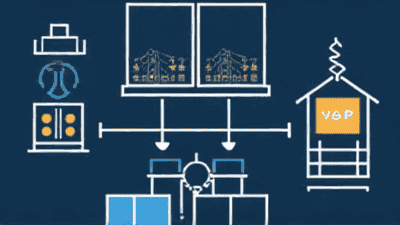
As technology continues to evolve, smart homes have become increasingly popular for their ability to enhance convenience, security, and efficiency. One of the most significant advancements in this area is the integration of energy monitoring systems. These systems provide homeowners with real-time insights into their energy consumption, helping them make informed decisions to reduce costs and environmental impact.
Energy monitoring systems are essential tools for modern homeowners who seek to optimize their energy usage. Here are some reasons why these systems are crucial in a smart home:
By providing detailed information about energy consumption, energy monitoring systems help homeowners identify areas where they can reduce usage. This can lead to significant savings on utility bills over time.
Reducing energy consumption is not only beneficial for your wallet but also for the environment. Energy monitoring systems encourage more sustainable living by highlighting opportunities to minimize waste.
These systems offer real-time data and historical trends, making homeowners more aware of their energy habits. This awareness can lead to more mindful consumption and long-term behavioral changes.
Energy monitoring systems can often integrate with other smart home devices, such as thermostats, lighting, and appliances. This integration allows for automated energy-saving routines and enhanced control over your home’s energy usage.
Energy monitoring systems can alert you to unexpected spikes in energy usage, which may indicate faulty appliances or other issues. Early detection can prevent costly repairs and improve the safety of your home.

Energy monitoring systems use a combination of hardware and software to track and analyze energy consumption. Here’s a breakdown of how these systems typically function:
Energy monitoring systems usually consist of the following hardware components:
Sensors: These devices are installed on your electrical panel or individual circuits to measure the flow of electricity. They collect data on voltage, current, and power consumption.
Gateway: The gateway is a hub that connects the sensors to your home network, allowing the data to be transmitted to the monitoring software.
Display Interface: Some systems include a dedicated display unit or mobile app that provides real-time energy usage information and insights.
The software component of an energy monitoring system is responsible for analyzing the data collected by the sensors and presenting it in an understandable format. Most systems come with a mobile app or web portal that allows you to:
The collected data is analyzed to provide actionable insights, such as:
There are several types of energy monitoring systems available, each with its own features and benefits. Here’s an overview of the most common types:
Whole-house energy monitors are installed at your electrical panel and provide a comprehensive overview of your home’s energy consumption. These systems track the total energy usage of your home and can often break down the data by individual circuits or appliances.
Plug-in energy monitors are devices that plug directly into an electrical outlet and monitor the energy usage of specific appliances or devices. These monitors are ideal for identifying energy-hungry devices and understanding their impact on your overall consumption.
Smart meters are utility-provided devices that measure and transmit energy usage data to your utility company. Many smart meters also provide real-time data to homeowners through a mobile app or web portal.
Home Energy Management Systems (HEMS) are advanced platforms that integrate energy monitoring with other smart home features, such as thermostats, lighting, and appliances. These systems provide a holistic approach to energy management and automation.

With so many options available, selecting the right energy monitoring system for your smart home can be challenging. Here are some factors to consider when making your decision:
Consider why you want an energy monitoring system. If your primary goal is to reduce energy costs, a whole-house monitor may be the best choice. If you want to focus on specific appliances, a plug-in monitor could be more suitable.
Ensure the system you choose is compatible with your existing smart home devices and platforms. Look for systems that integrate with popular platforms like Alexa, Google Home, or SmartThings.
Choose a system that is easy to install and use. Plug-in monitors are generally the simplest to set up, while whole-house monitors may require professional installation. Consider whether you prefer a mobile app or a dedicated display unit for viewing your energy data.
Energy monitoring systems can range in price from affordable plug-in monitors to more expensive home energy management systems. Determine your budget and weigh the features and benefits of each system against its cost.
Look for systems that provide detailed and actionable insights. A good energy monitoring system should offer real-time data, historical trends, and recommendations for reducing energy usage.
Consider whether the system can grow with your needs. If you plan to expand your smart home setup or monitor more devices in the future, choose a scalable system that can accommodate your goals.
Here are some of the most popular energy monitoring systems available today:
The Sense Energy Monitor is a whole-house system that uses machine learning to detect and identify individual appliances in your home. It provides real-time data and detailed insights into your energy usage.
The Emporia Vue is a whole-house energy monitor that offers detailed monitoring of individual circuits. It’s compatible with both 120V and 240V systems and provides real-time data through a mobile app.
The Eyedro Home Energy Monitor is a plug-in device that provides real-time energy usage data for individual appliances. It connects to your home network and offers insights through a mobile app.
The EcoBee SmartThermostat is a home energy management system that integrates energy monitoring with smart thermostat features. It provides insights into heating and cooling costs and helps optimize energy usage.
Watty is a whole-house energy monitor that uses artificial intelligence to provide detailed insights into your energy usage. It’s designed for easy installation and offers integration with smart home platforms.

Once you’ve chosen and installed an energy monitoring system, here are some tips to make the most of it:
Make it a habit to check your energy usage data regularly. This will help you stay aware of your consumption patterns and identify opportunities for improvement.
Use the insights from your energy monitoring system to set goals for reducing energy usage. Many systems allow you to track your progress and receive alerts when you’re on track or exceeding your goals.
Integrate your energy monitoring system with other smart home devices to automate energy-saving routines. For example, you can program your thermostat to adjust automatically when energy usage is high.
Use the detailed data from your system to identify the most energy-consuming appliances in your home. Consider replacing these appliances with more energy-efficient models or adjusting their usage patterns.
Try experimenting with different usage patterns to see how they affect your energy consumption. For example, run your dishwasher or washing machine during off-peak hours to reduce energy costs.
Involve everyone in your household in your energy-saving efforts. Share the insights from your energy monitoring system and encourage everyone to adopt energy-efficient habits.
Energy monitoring systems are powerful tools for optimizing energy usage in a smart home. By providing real-time data, detailed insights, and integration with other smart devices, these systems help homeowners reduce costs, minimize environmental impact, and enhance their overall living experience. Whether you choose a whole-house monitor, a plug-in device, or an advanced home energy management system, investing in an energy monitoring system is a step toward a more efficient and sustainable home. Evaluate your needs, explore the options available, and take control of your energy consumption with the right system for your smart home.